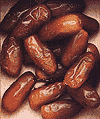DATESIn The Desert, A Date With The Sun!Sci4kids from the USDA Agricultural Research Service (ARS)
Your favorite breakfast cereal might have tasty little chunks of sweet, chewy dates. If so, the dates probably came from date palms in a hot, sunny desert in southern California. There, the palm trees get loads of sunshine and very little rain.
The trees love the heat, even when the temperature goes up to 118 degrees F or more. Date palms love the heat and sun so much, they stretch up toward the sun as high as they can, with all the leaves, or fronds, near the top. A date palm can grow 10 to more than 100 feet tall! 
If the palm tree is only 10 to12 feet tall, farmers use a ladder. But if the tree is taller, they might use a hydraulic platform--a kind of outdoor elevator--to reach the ripe dates.
California date ranchers grow 26,000 tons of dates (that's 52 million pounds!) --99.5 percent of all dates grown in the United States. Arizona growers produce the rest.
The sun's heat helps dates ripen--just as the sun also helps grapes dry so they'll turn into wrinkly, sweet raisins. Most dates are ready to harvest when they have lost some of their water or moisture to the super-dry desert air. This makes a date taste sweeter, since its natural sugars get bunched up in a smaller space. A "dry" date stays soft and chewy, though.
The grand-daddies of America's date palm trees came from countries in the Middle East in the early 1900s. That's when scientists with the U.S. Department of Agriculture started bringing many different kinds of small date palm trees to the Southwest. They figured out which kinds would thrive here, and which would produce the biggest, best-tasting dates for farmers.
Over the years, scientists with the Agricultural Research Service have planted a research garden of date palms in California. It's located about 150 miles southeast of Los Angeles near a desert town called Thermal, which means, of course, "heat." The date garden has more than 50 different types of date palms.
The scientists are very interested in palms that grow delicious dates. But they also want to know which palms have other great qualities. One of these valuable traits is the ability to fend off insects or diseases that would kill the tree or damage the date fruit. This trait--like many others--is the result of special genes in the date plant's cells.
In the future, scientists hope to give new traits to date palms that don't now have the genes needed for those traits. This is why they have the research garden. It gives them a huge "bank" of genes that might come in handy. In fact, the scientists call the garden a gene bank. They can use plants from the gene bank to breed new kinds of dates with new, different traits.
Scientists have dozens of gene banks around the country to guard many different kinds of crops--and keep the genes safe as well as handy. For example, there are gene banks for: - apples in Geneva, New York;
- peanuts in Griffin, Georgia;
- potatoes in Sturgeon Bay, Wisconsin;
- pineapples in Hilo, Hawaii.
By Marcia Wood, Information Staff, Agricultural Research Service
| 